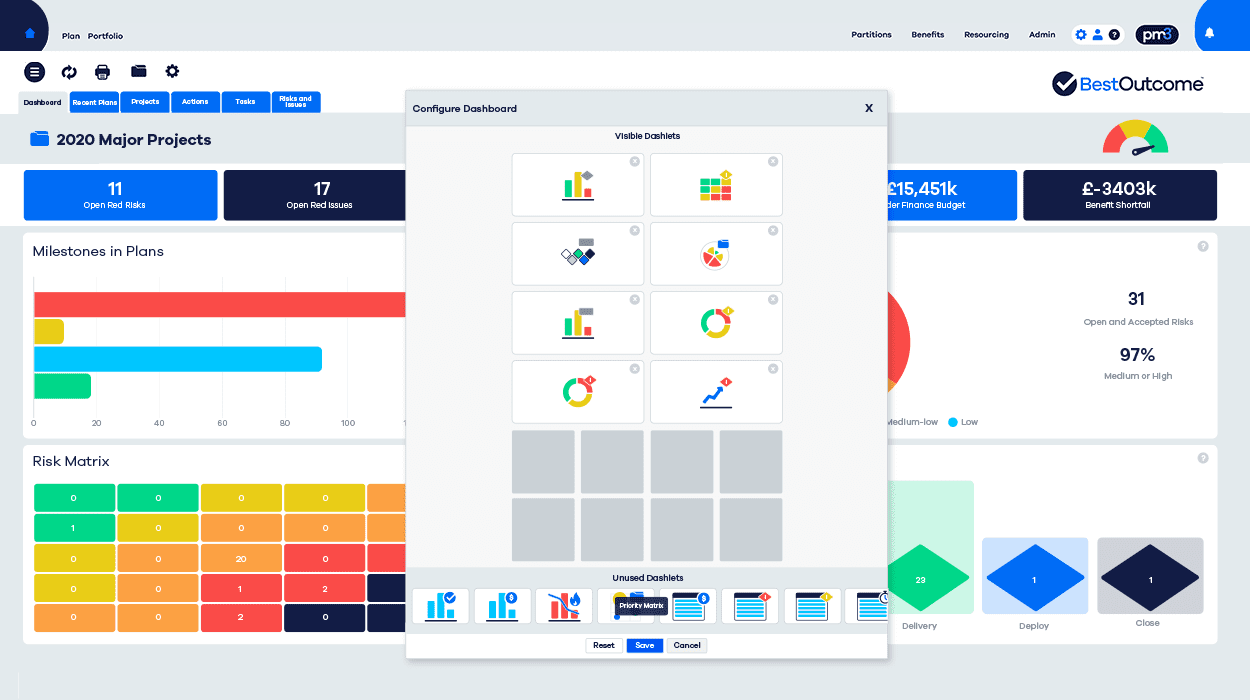Imagine you’re halfway through a critical project, and you suddenly realise that resources are running low, timelines are slipping and the objectives seem increasingly out of reach. How did things go wrong, and more importantly, how can you ensure this doesn’t happen again? This is where project evaluation comes in.
Project evaluation is not just a one-time activity but an ongoing process that provides crucial insights into every phase of a project.
Whether you are starting a new project, monitoring an ongoing one, or wrapping up a completed project, evaluation helps in understanding what works, what doesn’t and why. It’s about measuring performance, ensuring accountability and fostering continuous improvement.
This guide is designed for project managers who want to deepen their understanding of project evaluation. Whether you are dealing with small projects or large-scale programmes, you will get a comprehensive overview of different types and methods of project evaluation, step-by-step instructions on performing evaluations, and insights into essential metrics and data interpretation to help you improve future projects.

Project evaluation is a systematic process used to assess the design, implementation and outcomes of a project. It involves collecting and analysing information to understand how well a project is performing, whether it is meeting its objectives, and how it can be improved.
The primary purpose is to provide project managers and stakeholders with valuable insights that can inform decision-making, enhance performance and ensure accountability through a well-defined evaluation plan.Evaluation serves several key purposes:
Different types of project evaluation serve various purposes and provide insights at different stages of a project. Understanding these types helps project managers choose the most appropriate evaluation methods and apply them effectively.
Pre-project evaluation is conducted before the initiation of a project. It focuses on determining the feasibility, relevance and potential impact of the proposed project. This evaluation involves a needs assessment, feasibility study, risk assessment, stakeholder analysis and baseline data collection.
By performing a pre-project evaluation, project managers can make informed decisions about whether to proceed with the project, adjust its scope, or abandon it altogether.
Formative evaluation is conducted during the early stages of a project or during its implementation. The primary goal is to provide ongoing feedback that can be used to improve the project while it is still in progress.
This type of evaluation helps identify any issues or areas for improvement, allowing project managers to make necessary adjustments. Formative evaluation often involves collecting data on project processes, activities and initial outcomes.
Summative evaluation occurs at the end of a project and aims to assess its overall success and impact. It focuses on the outcomes and results achieved, comparing them against the initial objectives and goals.
Summative evaluation provides a comprehensive overview of the project’s effectiveness and can be used to inform future projects. This type of evaluation often includes both quantitative and qualitative data to measure success and capture lessons learned.
Process evaluation examines the implementation of a project, focusing on how activities are carried out and whether they align with the planned procedures. It assesses the efficiency and effectiveness of the project’s processes, including resource utilisation, timelines and stakeholder engagement. By understanding how the project was implemented, managers can identify best practices and areas needing improvement.
Impact evaluation looks at the broader effects of a project on its target population or environment. It assesses long-term changes and overall contributions to the project’s goals, such as improvements in quality of life, behavioural changes, or economic benefits.
Impact evaluation often requires a comparison between the situation before and after the project, using indicators that reflect the project’s objectives.
Developmental evaluation is used in innovative or complex projects where outcomes are uncertain, and the project evolves over time.
This type of evaluation supports ongoing adaptation and learning, helping project teams to navigate changes and uncertainties. Developmental evaluation involves close collaboration between evaluators and project teams to continuously refine and improve the project as it progresses.
Post-project evaluation takes place after a project is completed. It measures the project’s outcomes, impacts, and overall success. This evaluation includes outcome and impact assessment, performance analysis, benefit realisation, stakeholder feedback and documentation of lessons learned.
Post-project evaluation provides valuable insights into what worked well and what didn’t, helping to improve future project management practices and strategies.

This comprehensive guide will take you through the world of BIA, exploring its significance for companies of all sizes, its integration into business continuity plans, and practical steps for BIA implementation.
Selecting the right evaluation methods is crucial for obtaining accurate and meaningful data about a project’s performance.
There are several methods available, each with its strengths and suitable applications. Understanding these methods and evaluation criteria helps project managers choose the most appropriate approach for their specific needs.
Qualitative evaluation methods involve collecting non-numerical data to gain insights into the project’s processes and outcomes. These methods are useful for understanding complex issues, capturing stakeholder experiences and exploring reasons behind project success or failure. Common qualitative methods include:
Quantitative evaluation methods involve collecting numerical data that can be statistically analysed to measure project performance. These methods are useful for assessing measurable outcomes, comparing results against benchmarks and identifying trends. Common quantitative methods include:
Mixed methods combine qualitative and quantitative approaches to provide a comprehensive evaluation of the project. By integrating both types of data, mixed methods offer a more holistic understanding of the project’s performance and impact. This approach is particularly useful when both numerical data and stakeholder experiences are important for evaluation.
Selecting the appropriate evaluation method depends on several factors, including:

Conducting a thorough project evaluation involves several steps, from planning and data collection to analysis and reporting. Following a structured approach ensures that the evaluation process is systematic, transparent and effective.
The first step in conducting a project evaluation is to clearly define the project’s goals and objectives. These provide a benchmark against which the project’s performance can be measured. Understanding the intended outcomes and impacts of the project helps to focus the evaluation on the most relevant aspects.
Next, determine the scope of the evaluation. This includes deciding which parts of the project will be evaluated, the timeframe for the evaluation and the specific questions the evaluation will address. Defining the scope helps to ensure that the evaluation is manageable and targeted.
A detailed data collection plan outlines the methods and tools that will be used to gather information. This plan should specify:
With the plan in place, proceed with data collection. Ensure that data is gathered systematically and ethically, respecting confidentiality and obtaining necessary permissions from stakeholders. Use a variety of methods to ensure comprehensive data collection and triangulation of information.
Once the data is collected, analyse it against the project baseline to draw meaningful insights. This involves:
Prepare a detailed evaluation report that summarises the findings. The report should include:
Finally, apply the evaluation findings to improve future projects. Share the results with stakeholders, incorporate lessons learned into project planning, and adjust strategies to enhance performance and outcomes. Continuous learning and improvement are essential for project success.
 Our Success Stories
Our Success StoriesTo see how organisations across the UK are using PM3 to improve project delivery, explore our Success Stories featuring real-world examples and outcomes.
Effective project evaluation relies on the use of key metrics that provide quantifiable insights into a project’s performance and impact. By tracking and analysing these metrics, project managers can identify successes, areas for improvement and overall progress towards goals.
These metrics can be quantitative, providing numerical data, or qualitative, offering descriptive insights. The right set of metrics will depend on the project’s objectives, industry standards and stakeholder needs. Here are the 15 most important project evaluation metrics:
Choosing the most relevant metrics involves several considerations:
Collecting data is only the first step in project evaluation. The true value lies in interpreting this data to draw meaningful insights and applying these insights to improve project outcomes. This chapter will guide you through the process of making sense of your evaluation data and using it effectively.
Interpreting evaluation data involves several key steps:
There are several techniques for interpreting evaluation data, each suited to different types of data and analysis goals:
The ultimate goal of interpreting evaluation data is to apply the insights gained to enhance future projects. Here’s how to use your findings effectively:
Evaluating a project provides numerous advantages that enhance project performance and outcomes. By systematically assessing various aspects of a project through ongoing evaluation, managers and stakeholders can gain insights that lead to improved decision-making, better resource utilisation and increased satisfaction among all involved parties.
Project evaluation provides objective data that supports informed decision-making. By understanding what works well and what doesn’t, project managers can make adjustments that lead to more successful outcomes.
This data-driven approach reduces uncertainty and helps managers choose the best course of action at each stage of the project.
Regular evaluation helps identify areas where the project is excelling and where improvements are needed.
By continuously monitoring performance, managers can implement changes that enhance efficiency, effectiveness and overall project quality. This proactive approach ensures that potential issues are addressed before they become major problems.
Effective evaluation highlights how resources are being used and identifies opportunities for optimisation. This can lead to more efficient use of time, money and personnel, ensuring that resources are allocated where they are most needed. Better resource allocation can reduce costs and improve project outcomes.
Stakeholders, including clients, team members and sponsors, benefit from a transparent and accountable project evaluation process. Regular updates and clear communication of evaluation findings build trust and confidence.
When stakeholders see that their feedback is valued and that the project is being managed effectively, their satisfaction and support increase.
Through evaluation, project managers can identify and document best practices that contribute to project success. These practices can be shared across the organisation, promoting consistency and excellence in project management. Learning from successful projects helps improve future initiatives and fosters a culture of continuous improvement.
Evaluation provides valuable lessons that can be applied to future projects. By analysing what worked and what didn’t, project teams can refine their strategies and approaches. This continuous learning process enhances the skills and knowledge of the project team, leading to better performance over time.
Evaluation helps in identifying risks early and assessing their impact on the project. By understanding potential risks and how they were managed, project managers can develop more effective risk management strategies for future projects. This proactive approach reduces the likelihood of unforeseen issues and improves project resilience.
To maximise the benefits of project evaluation, it is essential to follow best practices that ensure the process is thorough, accurate and actionable. By adhering to these guidelines, project managers can enhance the quality of their evaluations and drive continuous improvement in their projects.
Incorporate evaluation as a regular part of the project lifecycle, rather than a one-time activity. Continuous monitoring and periodic evaluations allow for real-time feedback and adjustments. Establish feedback loops where data is collected, analysed and used to inform ongoing project decisions and improvements.
Actively involve stakeholders in the evaluation process to gain diverse perspectives and ensure their needs and expectations are met. Engage clients, team members, sponsors and other relevant parties by seeking their input, feedback and participation in evaluation activities. This inclusive approach fosters a sense of ownership and commitment to the project’s success.
Define clear and specific objectives for the evaluation. Understand what you want to achieve and how the evaluation will contribute to project improvement. Clear objectives help focus the evaluation process, making it more targeted and effective.
Employ a mix of qualitative and quantitative evaluation methods to gain a comprehensive understanding of the project’s performance. Qualitative methods provide in-depth insights into stakeholder experiences and project processes, while quantitative methods offer measurable data that can be statistically analysed. Combining both approaches ensures a well-rounded evaluation.
Ensure that the evaluation process is objective and transparent. Avoid bias by using consistent and standardised methods for data collection and analysis. Document the evaluation process and findings clearly, and share them with all relevant stakeholders. Transparency builds trust and credibility in the evaluation results.
Concentrate on generating actionable insights from the evaluation data. Identify specific areas for improvement and provide practical recommendations that can be implemented. Actionable insights help project managers make informed decisions and drive tangible improvements in project performance.
Be aware of common pitfalls in project evaluation and take steps to avoid them:

Selecting the right tools for project evaluation is crucial for ensuring efficient data collection, analysis and reporting. One such tool is PM3, an award-winning PPM (Project and Portfolio Management) tool designed to simplify complex projects.
PM3 is designed to focus on outcomes, making it suitable for managing a range of initiatives from small projects to large-scale programmes. Its user-friendly interface and configurable features reduce complexity and increase user adoption.
PM3 provides over 100 reports and drill-down dashboards, allowing managers to visualise data effectively. Customisable reports make accessing relevant metrics straightforward.
The resource management module tracks resource utilisation and identifies pinch points, crucial for evaluating resource efficiency and areas for improvement.
Supporting both agile and waterfall methodologies, PM3 ensures comprehensive evaluation insights regardless of the project approach.
PM3 facilitates project prioritisation and alignment with strategic objectives, enabling evaluation of alignment with organisational goals.
Team collaboration is enhanced through the PM3 platform and the PM3Team app, ensuring effective participation in the evaluation process.
PM3 streamlines data collection, making it easier to gather accurate information and provide real-time updates on project status. Automated reporting reduces manual effort and errors, ensuring high-quality data.
The tool’s analysis capabilities allow for in-depth performance reviews. Customisable dashboards ensure all relevant metrics are included.
Real-time insights into performance, resource use and benefit realisation support informed decision-making. Visual reports enhance stakeholder communication and transparency.
Insights from PM3 evaluations can inform future projects, driving continuous improvement. PM3’s learning portal, with videos and templates, supports ongoing development.
—
Main Image: Astrid IQ

Our products help you deliver successful change programmes and projects by always focusing on the overall business outcomes. Find out how our products can help you.
Discover PM3 Request a Demo